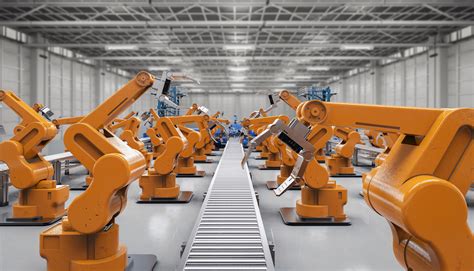Are you fascinated by the futuristic world of industrial robotics? From revolutionizing industries to advancing automation, the field of industrial robotics is constantly evolving and shaping the way we work and build. In this blog post, we will delve into the exciting realm of industrial robotics, exploring its impact, evolution, applications, anatomy, programming, collaborative nature, future advancements, challenges, and career opportunities. Whether you are a curious enthusiast, a professional in the field, or someone interested in the intersection of technology and industry, this blog post will offer valuable insights and perspectives on sculpting the future with industrial robotics. Join us on this thrilling journey as we unravel the intricacies of this innovative field and discover the endless possibilities it holds. Let’s embark on a fascinating exploration of industrial robotics and its boundless potential.
Table of Contents
Introduction: What are Industrial Robotics?
Industrial robotics refers to the use of robotic systems in industrial settings to automate tasks and processes. These robots are designed to perform a range of activities, such as assembly, welding, painting, packaging, and quality control, with precision and efficiency. The use of industrial robots has revolutionized the way many industries operate, leading to increased productivity, improved quality, and reduced costs.
These robotic systems are equipped with advanced technologies, including sensors, vision systems, and software, which enable them to perform complex tasks with a high degree of accuracy. They are also adaptable and can be reprogrammed to perform different functions, making them versatile and cost-effective for various manufacturing and production needs.
Industrial robots are commonly utilized in industries such as automotive, electronics, pharmaceuticals, food and beverage, and logistics. They play a crucial role in streamlining operations, enhancing safety, and meeting the growing demands of global markets.
As technology continues to advance, the capabilities of industrial robotics are expected to expand, leading to further innovation and integration within diverse industrial applications.
Revolutionizing Industries: The Impact of Industrial Robotics
Industrial robotics has had a profound impact on various industries, revolutionizing the way work is done and bringing about significant changes in efficiency, productivity, and safety. With the integration of robotic technologies in manufacturing, construction, and other sectors, the landscape of industries has been transformed, leading to a host of benefits and opportunities.
One of the key impacts of industrial robotics has been the enhancement of efficiency and productivity in manufacturing processes. The use of robots in assembly lines and production facilities has streamlined operations, reduced production times, and improved overall output. This has allowed companies to meet increasing demands, optimize their resources, and stay competitive in the global market.
Another significant effect of industrial robotics is the improvement of safety standards in various industries. By taking over hazardous or repetitive tasks, robots have helped reduce the risk of workplace accidents and injuries, creating a safer working environment for employees. This has not only contributed to a decrease in workplace-related incidents but has also resulted in higher employee morale and well-being.
Furthermore, the impact of industrial robotics extends to the creation of new opportunities and job roles. As the use of robots continues to grow, there is a greater demand for skilled professionals who can design, program, maintain, and supervise these advanced systems. This has led to the emergence of careers in robotic engineering, automation technology, and other related fields, offering individuals a chance to explore exciting and innovative career paths.
The Evolution of Industrial Robotics: From Assembly Lines to Advanced Automation
Industrial robotics has come a long way since its inception, evolving from the simple tasks of assembly line work to advanced automation. The evolution of industrial robotics can be traced back to the early 20th century, when the first mechanical arms were introduced to the manufacturing industry.
These early robotic arms were primarily used for repetitive tasks on assembly lines, such as welding and painting. Over time, advancements in technology led to the development of more sophisticated robots capable of performing a wider range of tasks with greater precision and efficiency.
As industrial robots became more advanced, they began to play a significant role in various industries beyond manufacturing, including construction, agriculture, and healthcare. Today, industrial robots are equipped with state-of-the-art sensors, artificial intelligence, and machine learning capabilities, allowing them to operate autonomously and adapt to changing conditions.
The evolution of industrial robotics has not only revolutionized the way goods are produced but has also led to increased safety, efficiency, and productivity in the workplace. With the continuous advancements in robotics technology, the future holds even greater possibilities for the integration of robots in various industries, paving the way for a new era of automation and innovation.
Applications of Industrial Robotics: Manufacturing, Construction, and More
Industrial robotics have revolutionized various industries, transforming the way manufacturing and construction processes are carried out. With their precision, speed, and flexibility, industrial robots have become indispensable in a wide range of applications.
Manufacturing is one of the primary areas where industrial robotics are extensively utilized. Robots are employed in tasks such as assembly, welding, painting, and material handling in automotive, electronics, and food production plants. Their ability to work non-stop and consistently deliver high-quality output has significantly improved production efficiency and product quality.
In the construction industry, industrial robots are used for tasks like bricklaying, demolition, and 3D printing of structures. Their ability to work in hazardous environments and perform repetitive tasks with precision has contributed to increased safety and reduced labor costs.
Besides manufacturing and construction, industrial robots can be found in various other applications such as agriculture, healthcare, and logistics. They are being increasingly adopted in tasks like harvesting crops, assisting in surgeries, and sorting and packaging goods in warehouses.
The Anatomy of Industrial Robots: Components and Functionality
Industrial robots are complex machines designed to perform a variety of tasks in manufacturing and other industries. These robots are made up of several components that work together to achieve precision and efficiency in their operations.
One of the key components of industrial robots is the manipulator, which is the arm-like structure responsible for carrying out the actual work. The manipulator is usually equipped with a variety of tools and end-effectors that allow the robot to perform tasks such as welding, painting, and material handling.
Another important component of industrial robots is the controller, which serves as the brain of the machine. The controller is responsible for interpreting instructions from the robot’s programming and coordinating the movement of the manipulator and other components to carry out tasks with precision and accuracy.
In addition to the manipulator and controller, industrial robots also consist of sensors, which allow the robot to gather information about its environment and make adjustments to its operations as necessary. These sensors play a crucial role in ensuring the safety and efficiency of the robot’s performance.
Programming Industrial Robots: Skills and Techniques
When it comes to programming industrial robots, it requires a specific set of skills and techniques to ensure that the robots perform their tasks efficiently and accurately. Industrial robots are used in a wide range of industries, from automotive manufacturing to food processing, and each application requires a different approach to programming.
One of the key skills required for programming industrial robots is a strong understanding of computer programming languages such as C++, Python, or Java. These languages are commonly used to write the code that controls the movements and actions of the robots, so a programmer must be proficient in these languages to effectively program industrial robots.
In addition to programming languages, programming industrial robots also requires a deep understanding of robotics and automation principles. This includes knowledge of kinematics, dynamics, and control theory, as well as familiarity with the various sensors and actuators that are used to interact with the robot’s environment.
Another important aspect of programming industrial robots is the ability to troubleshoot and debug the code. Since industrial robots are often used in high-stakes, high-precision applications, it is crucial that the programming is free from errors and bugs. A skilled programmer must be able to identify and fix any issues that arise during the programming process.
Collaborative Robotics: Humans and Robots Working Together
Collaborative robotics, also known as cobotics, is a growing field in the world of industrial automation. It involves the interaction between humans and robots in a shared workspace, where they work together to optimize efficiency and productivity.
One of the key features of collaborative robots is their ability to operate safely alongside human workers. Unlike traditional industrial robots, cobots are designed to perform tasks in close proximity to humans without the need for safety barriers or cages. This makes them ideal for applications that require human-robot collaboration, such as assembly lines, pick-and-place operations, and quality control processes.
With advancements in sensor technology and artificial intelligence, collaborative robots are becoming more adaptable and intuitive, allowing them to respond to human cues and adjust their behavior accordingly. This level of interaction opens up new possibilities for flexible manufacturing processes and seamless teamwork between humans and machines.
Overall, collaborative robotics is revolutionizing the way we think about industrial automation. By bridging the gap between humans and robots, cobots are enabling safer, more efficient, and more versatile production environments, leading to an exciting future of collaboration and innovation in the industrial sector.
The Future of Industrial Robotics: Advancements and Trends
Industrial robotics is on a trajectory of continuous advancement and the future looks promising with exciting trends on the horizon. The rapid pace of technological innovation is revolutionizing the industrial landscape, and industrial robotics is at the forefront of this transformative movement.
Advancements in industrial robotics are being driven by breakthroughs in artificial intelligence, machine learning, and sensor technologies. These developments are enabling industrial robots to become more intelligent, autonomous, and adaptable to complex manufacturing environments. As a result, industrial robots are increasingly capable of performing a wider range of tasks with greater precision and efficiency.
One of the most significant trends shaping the future of industrial robotics is the rise of collaborative robots, also known as cobots. These robots are designed to work alongside human workers, enhancing productivity and safety on the factory floor. The collaborative nature of these robots is opening up new possibilities for flexible and agile manufacturing processes.
Another key trend in the future of industrial robotics is the integration of Internet of Things (IoT) technology. This connectivity enables industrial robots to communicate and share data with other machines, systems, and cloud platforms. As a result, manufacturers can leverage real-time data analytics to optimize production processes and make informed decisions for continuous improvement.
Addressing Challenges in Industrial Robotics: Safety and Ethical Considerations
When it comes to industrial robotics, safety and ethical considerations are of utmost importance in order to ensure the well-being of workers and the ethical use of technology. With the increasing integration of robots into various industries, it is crucial to address and mitigate the potential challenges associated with their use.
One of the key challenges in industrial robotics is ensuring the safety of human workers who interact with robots on a daily basis. As robots become more advanced and capable of working alongside humans, there is a need to implement stringent safety measures to prevent any accidents or injuries. This includes developing safety protocols, implementing protective barriers, and providing comprehensive training for workers on how to safely operate and work alongside robots.
In addition to safety concerns, there are also ethical considerations that must be taken into account when it comes to industrial robotics. As robots become more autonomous and capable of making decisions, there is a need to address ethical dilemmas such as the potential displacement of human workers, the impact on job security, and the ethical use of robots in various industries. It is important to have discussions and guidelines in place to ensure that the integration of robots into the workforce is done in a responsible and ethical manner.
Addressing the challenges of safety and ethical considerations in industrial robotics requires a multi-faceted approach that involves collaboration between industry leaders, policymakers, and technologists. By prioritizing safety and ethical standards, we can harness the full potential of industrial robotics while ensuring that they are used in a way that prioritizes the well-being of workers and upholds ethical standards.
Bridging the Skills Gap: Training and Career Opportunities in Industrial Robotics
As the demand for industrial robotics continues to grow, so does the need for skilled professionals who can design, maintain, and operate these advanced technologies. Bridging the skills gap in the field of industrial robotics is crucial to meeting the industry’s demands and ensuring that businesses can benefit from the latest technological advancements.
Training programs in industrial robotics offer students the opportunity to learn about the design and operation of robots, as well as the programming languages and software used to control them. These programs provide hands-on experience with various types of industrial robots, preparing students for careers in manufacturing, construction, aerospace, and other industries that rely on automation.
Career opportunities in industrial robotics are diverse and offer the potential for growth and advancement. Graduates of training programs in industrial robotics can pursue careers as robotics engineers, automation technicians, and maintenance specialists. Additionally, professionals with experience in industrial robotics are sought after for their expertise in areas such as machine learning, artificial intelligence, and the Internet of Things (IoT).
As the industry continues to evolve, the demand for skilled professionals in industrial robotics will only continue to grow. By bridging the skills gap through training and career opportunities, businesses can remain competitive and harness the full potential of industrial robotics to drive innovation and efficiency.





